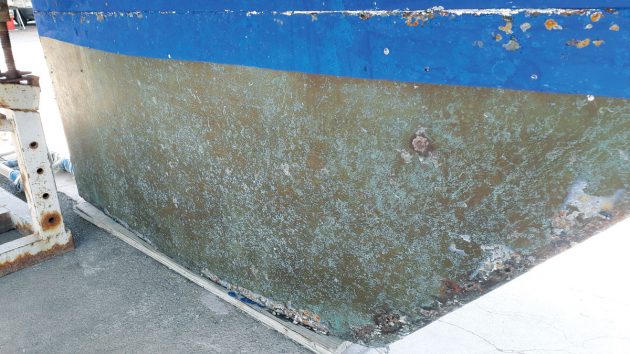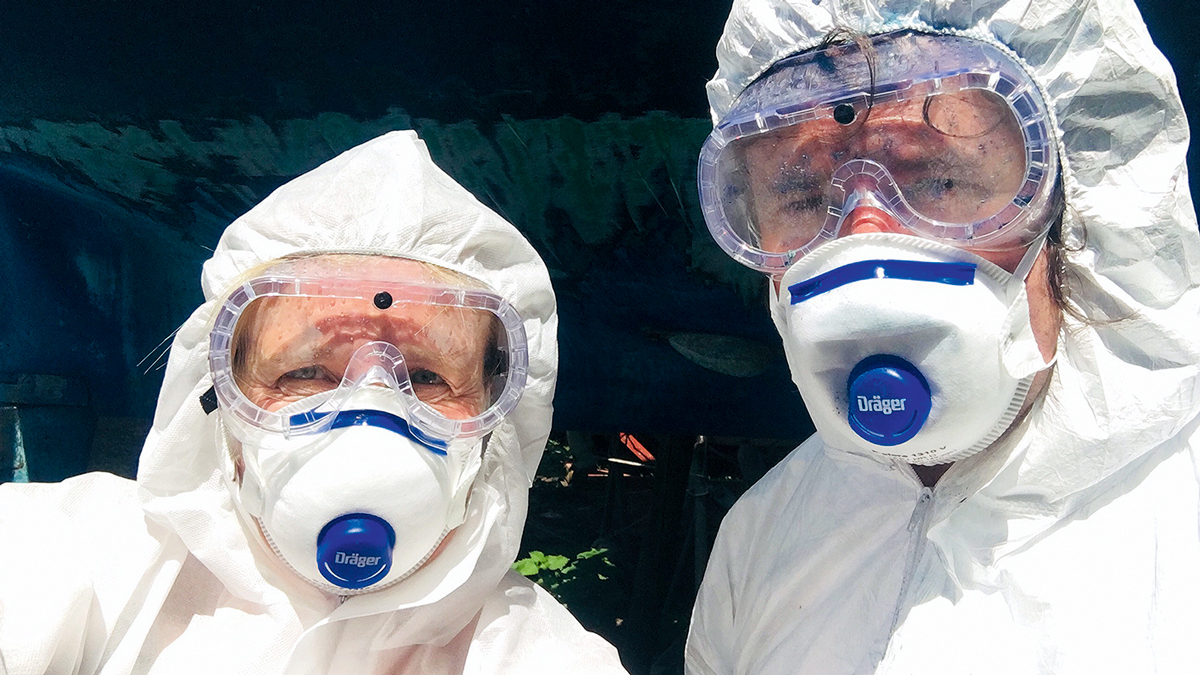Nick and Wendy Tyler apply both coatings to their Moody 37. But which one will last the distance?
Traditional vs Coppercoat antifoul: reader test
When buying our first boat in November 2018, a fin-keel Moody 37 built in 1985 by Plymouth Boat Projects, the surveyor told us Paper Moon had a slight case of osmosis and needed to be stripped back and dried out, writes Nick and Wendy Tyler.
Not knowing what this entailed, we had her hauled out on the day we took ownership and hoped to maybe go sailing one day.
We left her to dry out over the winter of 2018, frustrated that our sailing dreams were sitting on the hard in Oreston, Plymouth.
But we had the advantage of a very professional team who grit-blasted, filled and faired the hull, and re-primed both the keel and the hull.

Applying the Coppercoat antifoul to the hull. Credit: Nick and Wendy Tyler
Then in the spring came the big question: shall we use traditional antifouling or instead apply that ‘copper-powder-in-glue’ stuff?
We read up everything we could find and badgered everybody we knew for recommendations and experience.
Then we looked around for the chance of getting any of this done professionally at a reasonable price.
Eventually our budget limitations and desire to go sailing got the better of us, and we decided to go down the DIY route.

View of the prow, where even the white hard antifouling is worn through, September 2023. Credit: Nick and Wendy Tyler
We’d heard a lot of sailors’ tales of Coppercoat antifoul peeling off if the surface isn’t perfectly prepared, and how the temperature and humidity have to be ‘just right’.
As far as we could tell, the temperature and humidity in England is never ‘just right’, and all the boats that are getting the full Coppercoat treatment from professionals are in warmer climates or hiding in big tents somewhere along the south coast of England.
The other issue is that, according to the instructions, Coppercoat has to be applied ‘wet-on-tacky’, and like good varnish work, it is necessary to keep a ‘wet edge’.
With only two of us available, working daylight hours in a boatyard at weekends, we did not think we could reasonably cover the whole hull.
What we did
Then Nick had a bright idea. What if we Coppercoated the keel and antifouled the hull?
By doing that, we would be able to tell which of them worked best, and maybe choose to get the whole boat done in one or the other in a few years.
We also reasoned that if the Coppercoat peeled off, the keel was a relatively small area to re-paint with antifouling. So, that’s what we did!

Wendy applying the third coat of ablative paint. Credit: Nick and Wendy Tyler
The hull got some coats of hard antifouling as a base layer, then several coats of dark blue ablative paint, all in the hope of keeping the barnacles at bay.
Having been used to decorating with household paint, we were delighted with how well the blue ablative antifouling went onto virtually any surface, and how easy it was to achieve an even finish.
If only gloss were that easy to apply!
Continues below…
Antifouling: Everything you need to know
Here’s PBO’s guide to preparing for, choosing and using antifouling paints
Best antifouling paint: 8 leading options in head-to-head test
In June 2021 we coated the hull of a Hardy Commodore 42 with eight of the best antifouling paint products.…
Seajet Bioclean silicone antifoul review: Our verdict after one year on the water
Does silicone antifouling work? It’s not flying off the shelves yet, according to suppliers, but the results from our Project…
Cheap antifouling paint? Manufacturers explain how to coat your boat on a budget
What’s your most economical antifouling paint? The lower the level of fouling you’re up against, the cheaper the antifouling paint…
The keel got four coats of Coppercoat antifoul paint on top of a zinc/epoxy primer.
These were mixed and applied in a single day, allowing us to follow the manufacturer’s instructions as well as we could.
We had to keep mixing and stirring and the rollers gradually got heavier and heavier as the copper seemed to have an affinity for the roller, rather than the boat.
But we got it done and felt relatively pleased with the result.
The first repaint
Two years, and 5,400 miles later, we had sailed from Plymouth to Lanzarote by way of Spain, Portugal, and Madeira, and then back again to Lagos in the Algarve for a winter of repairs.
In January 2022, we had Paper Moon hauled out to replace a shaft seal and a broken engine mount.
This was the boat’s first haul out since Plymouth, and we were very pleased to find both the antifouling paint and the Coppercoat were doing fine.

View of Paper Moon’s rudder on the last haul-out; the ablative paint had worn right through to the white hard antifouling. Credit: Nick and Wendy Tyler
The most irritating cling-ons were tubeworms from the Canary Islands.
We bought several expensive tins of traditional antifoul and put another three coats on the hull.
The Coppercoat antifoul just needed a brisk rub-down with Scotch-Brite to re-activate it, and an even green colour was achieved with little effort.
With Paper Moon safely back in the water, we proceeded to sail through Gibraltar and across to Sardinia, coming back to the Algarve via the Balearics, Tangiers and Cadiz.
Atlantic circuit
Then, last September, it was time for the big adventure. We sailed down to the Canary Islands and then further south to the Cape Verde islands, across the Atlantic to Martinique before visiting the British Virgin Islands.
We then returned back to our home base in Lagos in Portugal via the Azores.
Paper Moon got another well-earned haul-out.
After 8,100 miles of (mostly) fabulous sailing, the difference in hull treatments was obvious.

Close up of Paper Moon’s hull with barnacles still clinging on to the ablative paint, September 2023. Credit: Nick and Wendy Tyler
The ablative antifoul had completely worn through on some parts of the hull, notably the rudder, prow and leading edge of the skeg.
The Coppercoat antifoul, however, was still virtually intact, and free of growth.
To be honest, the cast iron keel had blown off a few small patches as it corroded from its pores. But we haven’t yet heard of a treatment for cast iron that can stop this from happening.
Having had to spend a second large amount of money on 7.5lt of ablative antifoul, we repainted the hull with another three coats, and put her back in the water ready for another season.
The Coppercoat looks good enough that we are just going to let it ‘do its thing’ until the next haul-out.
Conclusion
Overall, we have to say we are very pleased with the result of the experiment.
Both surface treatments have experienced the same number of miles in the same water and sat in the same marinas and estuaries for the same length of time.
On reflection it isn’t a wholly fair comparison, because a lot of marine growth occurs within the first few inches of the waterline.
It should also be noted that the tubeworms and barnacles of the tropical seas adhere equally well to both surfaces.
We have no commercial interest in either product and certainly wouldn’t like to make a recommendation, but thought the results of our DIY experiment would be of interest to PBO readers.
Enjoyed reading Traditional vs Coppercoat antifoul: reader test? 
A subscription to Practical Boat Owner magazine costs around 40% less than the cover price.
Print and digital editions are available through Magazines Direct – where you can also find the latest deals.
PBO is packed with information to help you get the most from boat ownership – whether sail or power.
-
-
-
- Take your DIY skills to the next level with trusted advice on boat maintenance and repairs
- Impartial in-depth gear reviews
- Practical cruising tips for making the most of your time afloat
-
-







